#pre conquest art
Text
#ToucanTuesday:
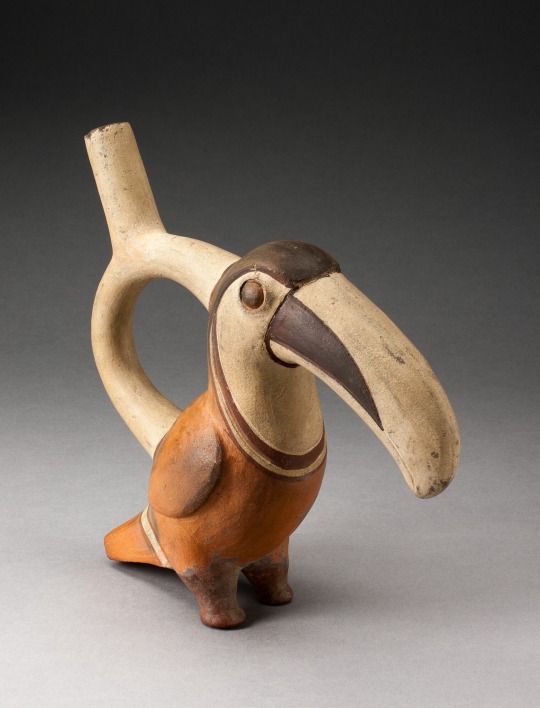
Handle Spout Vessel in Form of a Toucan
Moche culture, North Coast Peru, 100 BCE–500 CE
Ceramic & pigment
22.9 × 17.2 cm (9 × 6 3/4 in.)
The Art Institute of Chicago 1957.406
#animals in art#birds in art#bird#toucan#Moche art#Peruvian art#South American art#indigenous art#pre conquest art#sculpture#ceramics#pottery#polychrome#effigy vessel#Att Institute of Chicago#Toucan Tuesday
463 notes
·
View notes
Text
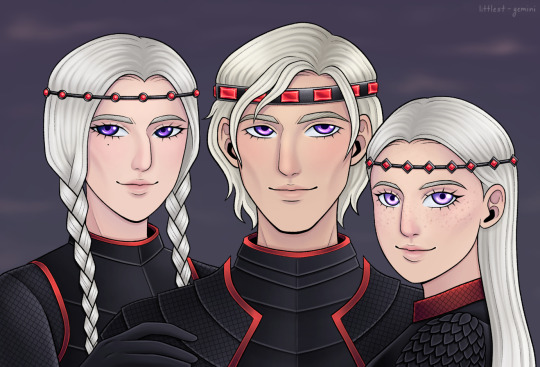
POV you are about to be Conquered™️
#a song of ice and fire#asoiaf#asoiaf art#aegon the conqueror#aegon targaryen#rhaenys targaryen#queen rhaenys#rhaenys the conqueror#visenya targaryen#visenya the conqueror#queen visenya#aegon’s conquest#pre asoiaf#house targaryen#game of thrones
192 notes
·
View notes
Text

Silly little concepts I had for the conquerors
I've been thinking a lot about the inhumane Targaryen beauty and in what way I should try to translate it to the paper, so I searched for roman statues and roman noses with those very high nasal bridges and sharp angles on their (very beautiful) noses, at the beginning I've felt a bit of fear about not making them attractive enough but honestly if my Visenya doesn't look as sharp and dangerous as Dark Sister, I don't want it
#rhaenys targaryen#rhaenys the conqueror#visenya targaryen#aegon i targaryen#asoiaf#fire and blood#fanart#pre asoiaf#aegon's conquest#I do think that Aegon and Visenya look a bit older here#but blame it on my decision of adding too much lines on their faces#If I was a casting director to any targaryen prequel#I'd bar Henry Cavill from any targaryen casting ever#even for Maegor#my art
54 notes
·
View notes
Text

Pencils mostly as an exercise in movement- inspired by some Coptic depictions of dancers


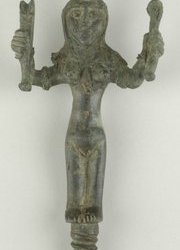
I don't know where the textile is housed, but these are in the Benaki Museum and Brooklyn, respectively
#cipher talk#my art#Coptic art#Kind of spite art because I saw the silly assertion that Copts shouldn't play ouds because they're associated with ~bellydancing~#Sir the dancers we depicted in art pre-Conquest were often naked. This is silly.#Stick to the argument that it's preferable we revitalize old instruments that have fallen out of use
24 notes
·
View notes
Note
Hi!
Do you know if there's any Jewish history in EH? There are a lot of old (pre-Inquisition) Jewish buildings/art in Spain, Catalonia, and Portugal, but I'm not sure if there are EH. I'm just curious, since I've learned a lot about Jewish life in Spain before the Inquisition, but never about Jewish life in EH, if there even was any.
Thank you!
Kaixo and thanks for your message!
Of course there's Jewish history in EH! In Gipuzkoa there never was a big community, as well as in Araba, with the exception of Guardia. In Bizkaia, Balmaseda was the biggest center for Jews, but sadly they were forcibly expelled around 40 years prior to the expulsion from Castile. Jewish people flourished mainly in the southern side of Nafarroa in Muslim times: there were thriving Jewish communities in Lizarra, Tutera, Tafalla, even Iruña.
Luckily this didn't change after the Reconquista! Jewish people were mainly merchants and moneylenders - profession banned for Christians - and they would work with peasants and nobility alike. They were also wine makers, and this wine was very much appreciated not only in the kingdom of Navarre, but also in Aragón and Castile. Navarrese kings supported Jewish communities and welcomed any Jew from other region.
There's a tragic but moving story about this time. The Jewish community of Gasteiz was forced to leave, but they agreed to hand over their cemetery to the city on the condition of respect the ground and don't build on it. The promise was respected for 460 years until 1952, when Jewish representatives agreed with the town hall that the ground was available for any use. Nowadays, it's a park with this monument to Jewish people. The neighborhood is called Judimendi, "the mountain of Jewish people".
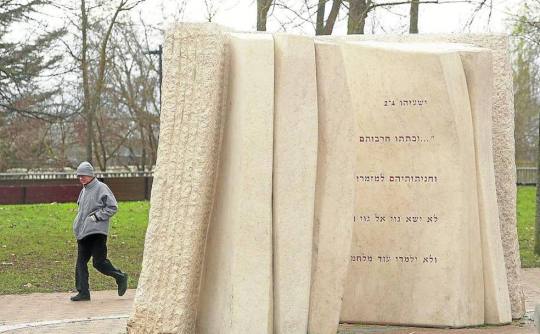

In fact, when the kingdom of Castile ordered the expulsion of Jews from Castile, most of them moved to the kingdom of Navarre. But after the conquest by Castile in 1512, Jews and Muslims were effectively expelled from their home. Most of them didn't go too far, just across the border, to Baiona.
Baiona welcomed Basque, Spanish and Portuguese Jews, gathering a very important community that led to call the town the little Jerusalem at one time. There's a much modern legacy there than south the border, for example, there's still a functioning synagogue.


After the French revolution, Jews were reocgnised the same rights and duties than any other French, so they kept their businesses and in Baiona, many of them devoted themselves to chocolate - still one of the best in Europe, I must add.
But during WW2 and nazi occupation, maaaany of these Jewish people were captured and led to extermination camps. The community didn't die, though, and they welcomed a new wave of Jewish refugees in the 60s due to the French-Algerian war.
René Cassin, one of the fathers of the Declaration of Human Rights, was a Jew from Baiona, btw.
Nowadays in Euskadi there are just around 300 Jews, while in Iparralde this figure is bigger but not super high (just around ~3,000 in the whole Aquitaine).
53 notes
·
View notes
Text
My apologies, let me delve even further into this fascinating aspect of Wednesday Addams' personality. While it's true that Wednesday is not one to seek physical contact, seduction, or embrace conventional notions of romantic love, the influence of her upbringing by Gomez and Morticia Addams has left a distinctive mark on her way of relating to the surrounding world.
Being the daughter of two peculiar and passionately enamored individuals like Gomez and Morticia, Wednesday was raised with the belief that any man who managed to capture her interest would practically fall at her feet. Morticia, with her elegance and mystery, imparted to her the art of seduction and conquest, endowing her with an innate ability to drive any man wild with just a glance.
Despite possessing this inherent power of seduction, Wednesday consciously chooses not to wield it overtly. Her reluctance to engage in physical contact and her refusal to immerse herself in conventional romanticism are not in contradiction to the upbringing she received; rather, they affirm her autonomy and determination. Wednesday opts to reserve that power for herself, demonstrating that her identity transcends conventional expectations and challenges established norms.
Ultimately, this complexity in her personality adds a fascinating layer to Wednesday Addams. Despite hailing from an unusual lineage, she remains a determined individualist, living by her own rules in a world that often expects us to follow a pre-established script. In a surprising twist, what could be shocking is the fact that, despite expectations and comments about her sensuality, Wednesday is appreciated by Tyler in a way that goes beyond mere physical attraction. He values her quirkiness and allure authentically, without succumbing to the sexualization or fetishization that others might project onto her. Tyler's unique approach to Wednesday adds an intriguing nuance to their connection, challenging conventional perceptions and creating a distinctive dynamic between the two characters.

#wednesday addams#tyler galpin#wednesday netflix#wednesday x tyler#tyler x wednesday#wednesday and tyler#tyler and wednesday#weyler#wyler
69 notes
·
View notes
Text
I made myself a Fire Emblem theme for my solitaire game
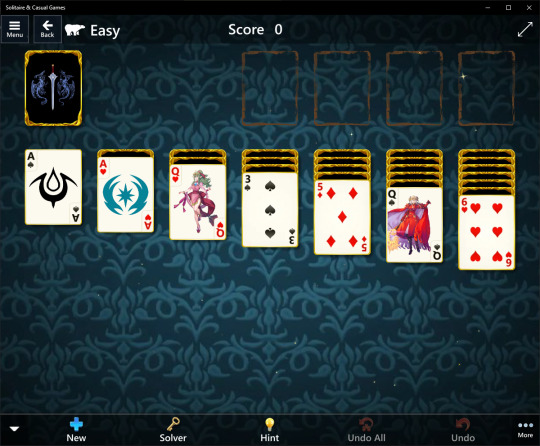


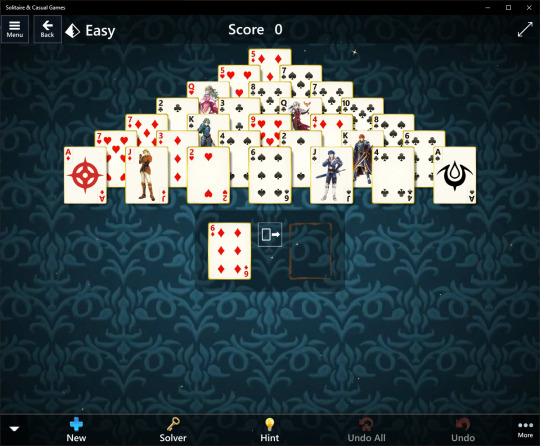
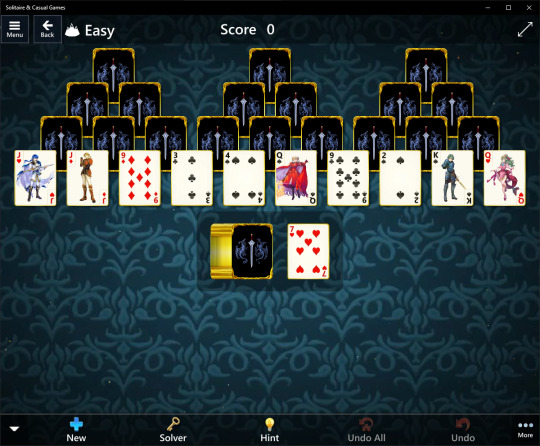
Deets under the cut
Base theme: Fable
Deck: Solitaire Celebrates
Effect: Stars
PLAYING BACKGROUND:

CARD BACKING:

ACES:
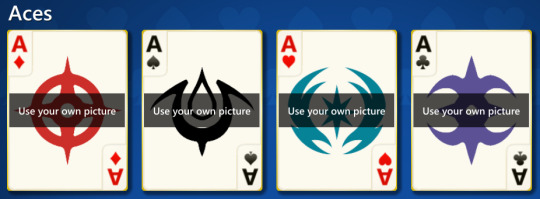
Ace of Diamonds: Hoshido/Birthright
Ace of Spades: Mark of Naga/Brand of the Exalt
Ace of Hearts: Valla/Revelation
Ace of Clubs: Nohr/Conquest
KINGS:
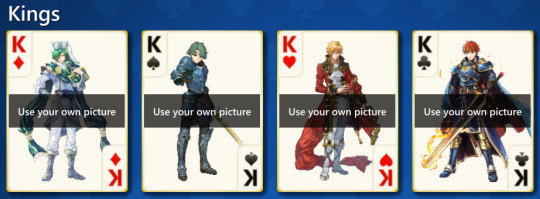
King of Diamonds: Lewyn
King of Spades: Alm
King of Hearts: Eltshan
King of Clubs: Eliwood
QUEENS:
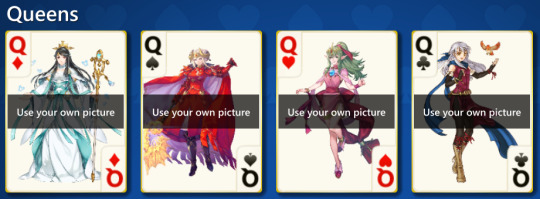
Queen of Diamonds: Mikoto
Queen of Spades: Edelgard
Queen of Hearts: Tiki
Queen of Clubs: Michaiah
JACKS:

Jack of Diamonds: Forde
Jack of Spades: Inigo
Jack of Hearts: Seliph
Jack of Clubs: Leo
IMAGE SOURCES:
Background: Here
Card backing: Here
Aces: The French Wikipages for Awakening and Fates
Face cards: Heroes and official art [Inigo specifically here]
FUN FACTS NOBODY ASKED FOR:
The face cards did not align this way naturally. All of them had to be zoomed in at least twice, most four, and a few had to be scooted over a little to avoid being cropped in the wrong places or to fix general alignment issues
The game doesn't properly support transparent images, so I had to give each face card a background; really all I did was colour drop the deck's base colour and use that as the background so it would match
Each face card was shrunk to the card's base dimensions [422x562] with the background being twice that size [844x1124] to allow for easier placement without running into a black background because of said transparency issues
I didn't make any changes to the playing background. I just set it and left it as is
The card backing isn't quite aligned in the center, but I have no motivation to try and fix that right now
The backing border was completely unintentional. I chose that deck to build off of simply because of the gold rim around the face-up cards. I didn't realise it would come with a backing border, but hey it works
I chose Fable as the base theme to build off of for two reasons: 1. Aesthetic™, and 2. The background music is the closest to Fire Emblem music the game has [I really wish you could choose your own in-game ambience instead of having to use a preset theme first]
The stars effect has no real impact on the theme, I just like it
I initially wanted Ferdinand to be the Jack of Diamonds, but I didn't want to use his pre-skip design, which is all Heroes had, so Forde was chosen instead
Takumi was briefly considered for Jack of Diamonds and King of Clubs before those roles went to Forde and Eliwood
Ishtar was going to be the Queen of Clubs, but I decided three Genealogy characters was enough, so Michaiah took this spot
Other candidates for Queen of Clubs were Cherche, Celica, Seiros, and Eirika
I went with the Chrom!Inigo edit instead of normal Inigo or Lazward simply because Chrom!Inigo is best Inigo and you cannot change my mind
Alm, Michaiah, and Forde are the only ones who use official art instead of Heroes art. I preferred Alm and Michaiah's official art while Forde isn't even in the game yet [get on that, IS]
I originally wanted to use Edelgard's official post-skip art as I didn't [and still don't] like how her Heroes art sharply cuts off, but it ultimately clashed badly when trying to align it, so I had to use her Legendary alt [her pre-skip and Three Hopes designs were out of the question from the get-go]. I aligned the cutoff with the edge of the card as best I could and I'm surprised it worked
The only set in stone characters from the very beginning were Eltshan, Seliph, and Inigo. The rest I decided as I went on
Tiki was completely spur of the moment. As soon as I remembered she existed, I was like "Oh yeah, adult Tiki would be a perfect Queen of Hearts". I saw her Brave alt and didn't look back
I briefly considered using Eltshan's performance alt, but decided against it
While I knew I wanted Seliph as the Jack of Hearts, I initially wasn't sure which version to use, but I ultimately went with the version I liked the most, which was his Brave alt
Lewyn was a toss-up as to which version I wanted to use, but I went with his festival alt as I liked it more than his normal version
Other characters I considered but with no solid placement were Sigurd, Arvis, Lucina, Ayra, Soleil, Dorothea, Olivia, Deirdre, Say'ri, Elincia, Ryouma, Innes, Tana, Ephraim, Felix, and Constance
Inigo and the aces required some additional editing to remove their white backgrounds before setting up the off-white backgrounds they were supposed to have for this set. I worked on Inigo's for so long trying to edit out lossy pixels around the edges of his art that the editor crashed on me. Hurray for autorecovery
#fire emblem#microsoft solitaire#i'm seriously in love with this i've looked at this for five hours now#though technically i made this theme a few days ago but who cares
21 notes
·
View notes
Text
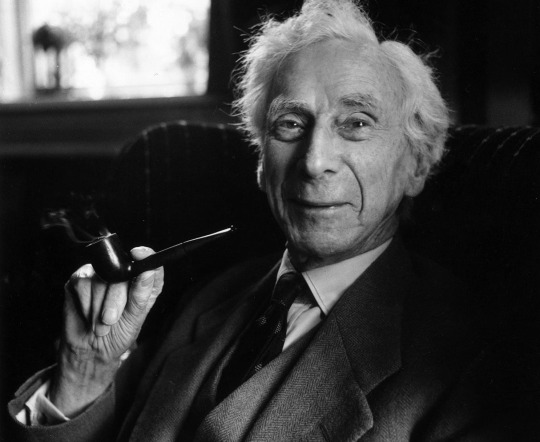
What is the secret of happiness? Russell's answer —
”The secret of happiness is this: Let your interests be as wide as possible, and let your reactions to the things and persons that interest you be as far as possible friendly rather than hostile.”
Bertrand Russell, The Conquest of Happiness (1930)
” ... the world may be plunged in war, knowledge in some direction may be hard to achieve, friends may die. But pains of these kinds do not destroy the essential quality of life.”
The Conquest of Happiness (1930) by Bertrand Russell pre-dates the modern genre of self-help popular/philosophy by decades. This work presents Russell's rationalist prescription for living a happy life, mainly the importance of cultivating interests outside oneself and the dangers of passive and base pleasure. The Conquest of Happiness (1930) is often cited as one of Bertrand Russell's most accessible and favorite books.
Excerpts The Conquest of Happiness (1930) by Bertrand Russell
━━
”If you are happy, ask yourself how many of your friends are so. And when you have reviewed your friends teach yourself the art of reading faces make yourself receptive to the moods of those whom you meet in the course of an ordinary day.
A mark in every face I meet,
Marks of weakness, marks of woe
says William Blake. Though the kinds are different, you will find that unhappiness meets you everywhere.”
— Bertrand Russell, The Conquest of Happiness (1930), Part I. Causes of Unhappiness, Ch: I, What Makes People Unhappy?, p. 9
”The secret of happiness is this: Let your interests be as wide as possible, and let your reactions to the things and persons that interest you be as far as possible friendly rather than hostile. The world is vast and our own powers are limited. If all our happiness is bound up entirely in our personal circumstances it is difficult not to demand of life more than it has to give. And to demand too much is the surest way of getting even less than is possible. The man who can forget his worries by means of a genuine interest in, say, gardening, or the life history of stars, will find that, when he returns from his excursion into the impersonal world, he has acquired a poise and calm which enable him to deal with his worries in the best way, and he will in the meantime have experienced a genuine even if temporary happiness.”
— Bertrand Russell, The Conquest of Happiness (1930), Part II. Causes of Happiness, Chapter X: Is Happiness Still Possible?, p. 140
”I was not born happy. In adolescence, I hated life and was continually on the verge of suicide, from which, however, I was restrained by the desire to know only more mathematics. Now, on the contrary, I enjoy life; I might almost say that with every year that passes I enjoy it more. This is due partly to having discovered what were the things that I most desired, and having gradually acquired many of these things. Partly it is due to having successfully dismissed certain objects of desire — such as the acquisition of indubitable knowledge about something or other — as essentially unattainable. But very largely my current happiness is due to a diminishing preoccupation with myself.
Gradually I learned to be indifferent to myself and my deficiencies; I came to centre my attention increasingly upon external objects: the state of the world, various branches of knowledge, individuals for whom I felt affection. External interests, it is true, bring each its own possibility of pain: the world may be plunged in war, knowledge in some direction may be hard to achieve, friends may die. But pains of these kinds do not destroy the essential quality of life, as do those that spring from disgust with the self.”
— Bertrand Russell, The Conquest of Happiness (1930), Part I. Causes of Unhappiness, Ch: I, What Makes People Unhappy?, pp. 18-9
Image: A rather cheerful Bertrand Russell in his private study at his home in Penrhyndeudreath, Gwynedd, United Kingdom (1959).
26 notes
·
View notes
Photo
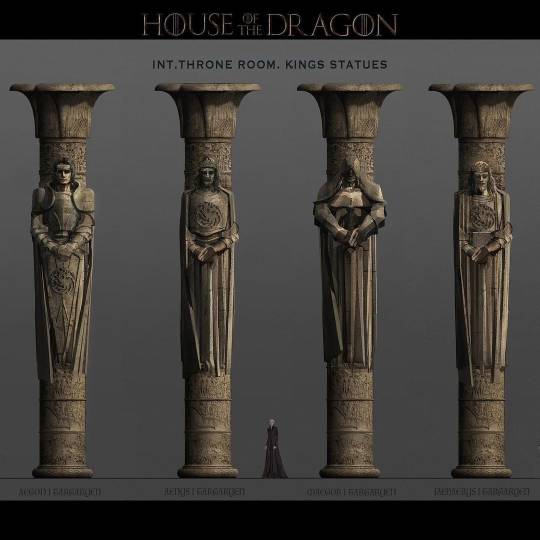
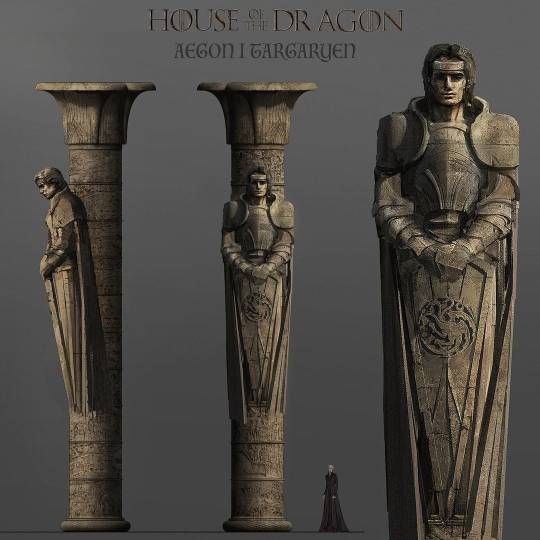


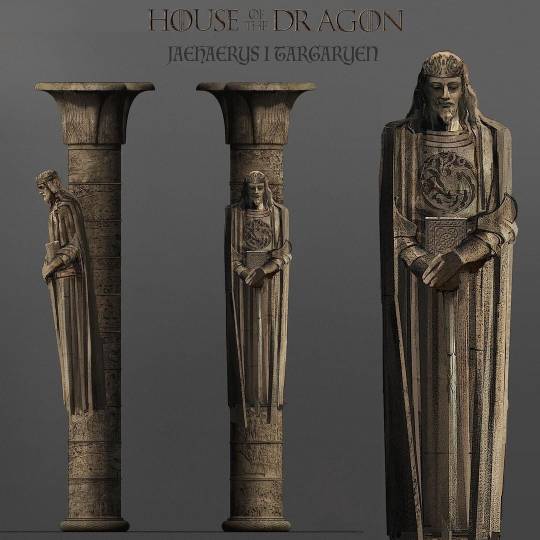
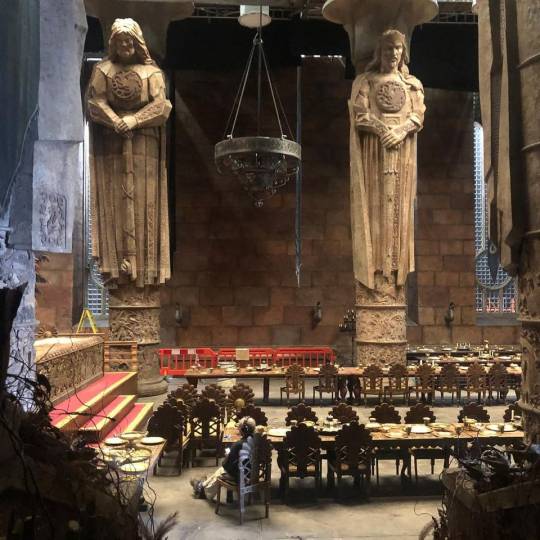

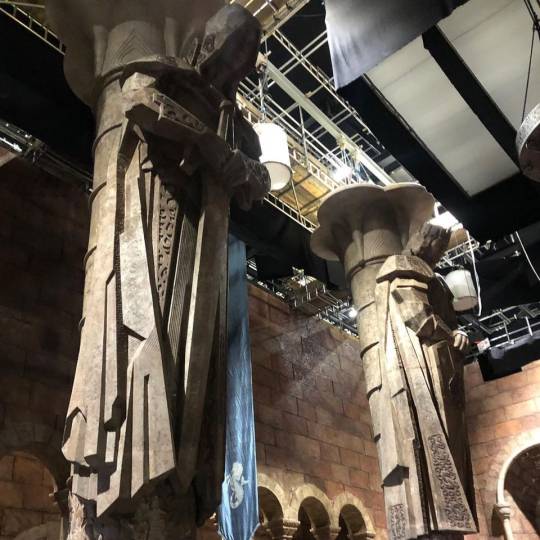
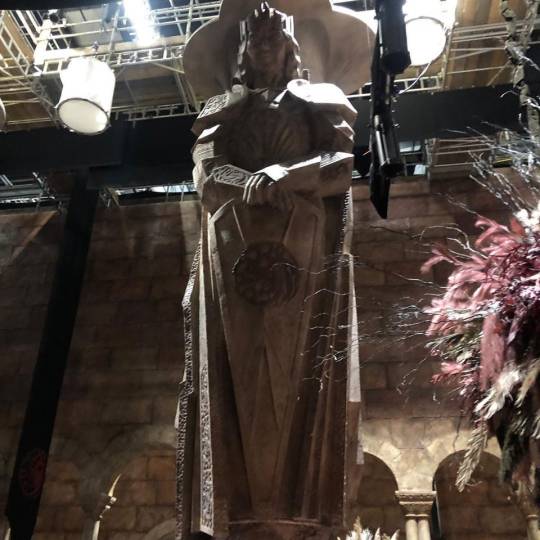
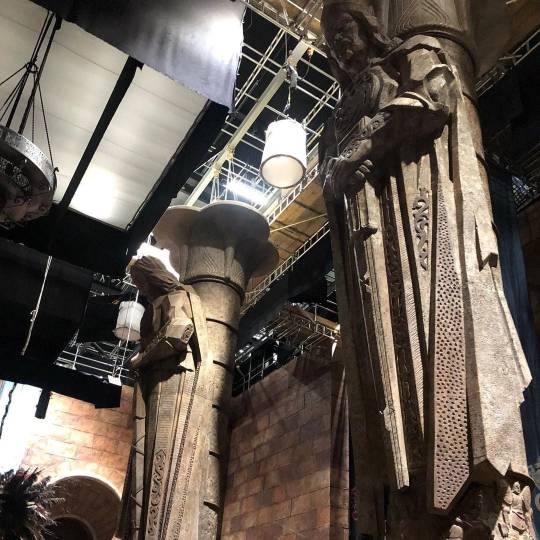
Targaryen Kings Statues Concept Art Released by Qingling Zhang
I don’t have the time to do a proper “art in HotD” writeup for these but I just wanted to add them to the posts because I’m absolutely thrilled to see the Great Hall so well lit and with this level of detail. I hope that in the next seasons this amazing set gets the attention it deserves because the craftsmanship and attention to detail that has been poured into it deserves to be highlighted -- I’m not going to lie, the statues looked a lot more nondescript in the show, enough that I assumed they were meant to be generic pre-Conquest ancestors, while in fact they are THEE Targ kings from Aegon I to Jaehaerys (so actually covering the dynasty up until very recent times), each with his own defining characteristics. Some stray observations:
I especially love how Maegor has been designed as a hooded, faceless figure, a way to acknowledge his place in the dynasty (although he’s the only one who doesn’t display the Targaryen sigil) but also erase his features because of his infamy, and a blatant callback to the iconography of the Stranger
Will the addition of other kings be featured in future episodes? in F&B, Aegon II commissions colossal statues of Aemond and Daeron to be built in King’s Landing, and this might be a way to integrate that tidbit from the book into the show.
These well lit bts shots show a pretty nice glimpse of the lower part of the columns, though to be honest I’m still a bit at loss on what *exactly* they represent besides “battle scenes with dragons”. The only impression I get is that they look kind of samey, so they probably all represent the same event, or series of events, regardless of the king covering the upper half of the column.
The wedding table also seems to be decorated with a bas relief roughly in the same style as the columns, depicting a chariot race (it’s hard to make out the detail but I doubt it’s a battle as a martial theme doesn’t feel fitting for a wedding, especially not one arranged by decidedly nonmartial Viserys)
(more art in hotd) - (more art in westeros)
103 notes
·
View notes
Text

Reliquary Cross
Anglo-Saxon, 900-1000
Historical significance: The cross is one of the rare surviving pieces which give substance to descriptions in contemporary documentary sources of the sumptuous church furnishings of pre-conquest England. The destruction wrought by Vikings, Normans and the Reformation have made such survivals so uncommon.
The enamels are unique in Anglo-Saxon art and may have been made by an English goldsmith familiar with German work. A fragmentary and not totally legible inscription around the edge of the cross seems to list the relics of saints once contained in the cavity beneath the ivory figure of Christ.
16 notes
·
View notes
Text

Another Spondylus shell ornament, Culture Jama-Coaque, Ecuadorian North Coast 500 BCE - 1530 CE, w3.4 x h6.9 cm. Museo Casa del Alabado / INPC. Listed as a "zoomorphic ornament," but the first thing it made me think of was a male Magnificent Frigatebird (Fregata magnificens), a native species…

#Jama-Coaque art#Ecuadorian art#South American art#Indigenous art#pre conquest art#ornament#shell#Spondylus#bird#birds in art#frigatebird#Magnificent Frigatebird#Museo Casa del Alabado#species ID
573 notes
·
View notes
Text

Rhaenys Targaryen
Is that meant to be a flute? Yes. Is it actually functional? Who knows. I made this rhaenys the same time I made this Visenya but I was dissatisfied with the hands, so i changed the hands and got references for the flute.
#rhaenys targaryen#house targaryen#asoiaf#my art#fanart#pre asoiaf#twoiaf#aegon's conquest#valyrianscrolls
36 notes
·
View notes
Text
Phyrexia

(The Fourth Sphere by Dave Kendall)
What is Phyrexia?
Phyrexia is a disease. It spreads, infects, and consumes. Phyrexia is a faith. It has gods, beliefs, and practices. Phyrexia is a threat. It's coming for you.
Phyrexia is one of the oldest and most unique factions in the card game Magic the Gathering. It has a focus on machinery and body horror that blurs the line between fantasy and science fiction. It has a long history, both within the fiction and as a fiction, and style that draws inspiration from a lot (Hi HR Geiger) but is fully its own idea; all this makes it ripe to translate to Pathfinder. (Innistrad, for example, also has rich history, but is the exact same niche as Ustalav, so I have no reason to make conversions.) This page intends to serve as a guide to Phyrexia for outsiders, as well as outline the conversion I'm making.
Old Phyrexia in Magic: the Gathering
(I am not an expert on the pre-mending lore of MtG; this intends to serve as a drive-by of the important points. That era of Magic is messy and has a lot of nits and details.)
In lore, Phyrexia began as a sort of cult surrounding a man named Yawgmoth, a doctor from an ancient science-magic society called the Thran. Technically, the original plane of Phyrexia was not created by Yawgmoth, but by a powerful Planeswalker (interdimensional godline being whose power would later get massively nerfed, as a category), but Yawgmoth quickly made it his own.
From there, the humans he brought with him turned to biomechanical experimentation and built a religion aroung Yawgmoth, who became known as the Father of the Machines. They were, unfortunately, trapped on the plane- Yawgmoth (who had ascended to a godlike state) wished to bring his conquest back to Dominaria (the plane from which they came) and beyond.

(Gix, Yawgmoth Praetor by Anna Bodedworna)
There were two major incursions of Phyrexia into Dominaria- first, the Brother's War, a story that was old when Magic was new. Two brothers- Urza and Mishra- had found powerful Thran artifacts, which lead to a power struggle between them. Mishra eventually found a Phyrexian portal, became corrupted (a recurring theme of Phyrexia), and eventually lost when Urza unleashed a magical nuke on the plane, hurtling Dominaria into a supernatural ice age and turning him into one of the godlike Planeswalkers.
The second was the conclusion of the Weatherlight Saga, an arc somwhat orchestrated by the now-ancient being that Urza had become and focusing on a man named Gerard and the crew of an interplanar vessel called the Weatherlight. They first show up having corrupted and taken over Rath, as well as Gerard's adopted brother Vuel. The saga concludes with the plane of Rath being overlaid onto Dominaria in an event that ended with most of the cast dead and Phyrexia and Yawgmoth as it stood destroyed, where they would stay for about a decade.
New Phyrexia in Magic: the Gathering
In 2009 Scars of Mirrodin was released, revealing that the setting of Mirrodin (Magic's other most original and interesting setting, sigh) had in fact been corrupted by Phyrexian Oil. The war, which lasted a year in real life, saw Mirrodin being almost entirely consumed and remade into New Phyrexia, a setting with a new art direction and five new leaders.

(artist unknown)
New Phyrexia, and exploring it card-by-card on a now defunct MtG card archive, was my personal introduction to the setting, and the style of Phyrexia that I am most fond of. It now encompassed all five colors of Magic, each with their own distinct subfaction, and felt less like an 80s metal album cover and more like its own, separate thing (for better or worse, to be clear, 80s metal album covers own).
In the 2020s, New Phyrexia had an arc where they had managed to successfully travel to other planes, and used that to do a big multiverse invasion that ended with all but one of their leaders dead and the nature of planes and planeswalkers in the wider MtG setting changed in a precedented paradigm shift.
Phyrexia on Golarion
So, with all that out of the way, let's talk about how I plan to translate that into MtG.
Phyrexian Beliefs
Phyrexians are supremacists of a sort; they believe that their way, darwinist philosophy surrounding the forced merging of metal and flesh, is the one true way. Fortunately, they are not here to exterminate others- simply to convert them, by force. "All will be One."
To this end they spread across the galaxy, consuming entire planets and converting their flesh to glorious Phyrexian constructs.
Yawgmoth
Yawgmoth is the progenitor of Phyrexia and its god, although by New Phyrexia he's very much dead. The five praetors took his place, with him existing mostly as allusions, even as a past failure that they will not replicate! (spoiler: they fail).
Personally, I like Yawgmoth existing in past tense. He was the god of Phyrexia, but he has been killed- possibly by some great Good divinity trying to end his scourge, more likely through conflict with the nihilistic Dominion of Black. Either way, his name is spoken in Phyrexia with both reverence and shame, and the five Praetors now each carry a fraction of his divinity.
The Five Praetors
Now in Magic canon 4/5 of them are dead now, and during the lead-up there was a lot of political jockeying, but I will have them as they existed in between NPH and the Invasion arc; With Elesh Norn as de facto leader, Jin-Gitaxias and Vorinclex respecting her but doing their own thing, and Sheoldred and Urabrask believing in Phyrexia but not in Norn's graces.
Planes and Planets
The nature of Planes in MtG is different from planes in Pathfinder/DnD; they're their own self-contained world, each possibly with their own cosmology, rather than being the cosmology of one coherent world. As such, I am changing Phyrexia from an interplanar threat to an interstellar one.
The Praetors, while about on the level of a nascent demon lord, are divinities of the material plane; they lack a home in the outer sphere.
Phyrexia and Other Factions
Because the Praetors are acting as their own divinities, Phyrexia has little to no relationship with the gods at work on Golarion, as well as with the Outer and Elder gods.
As I alluded to before, Phyrexians have a poor relationship to the Dominion of Black. The Dominion is nihilistic, seeking to destroy all life, while the Phyrexians seek to consume and convert it. If you want to take the Illithids from @thecreaturecodex's conversion, they almost certainly have a poor relationship with them too.
If your Dark Tapestry is feeling a bit crowded but you want to include Phyrexia, I would personally use them as a replacement for the Dominion. If you did so, I would moisturize Numeria so to speak, replacing much of its harsh desert with noxious swampland more palatable to Phyrexian tastes.
53 notes
·
View notes
Text
Deep dives into folklore: Mexican folklore
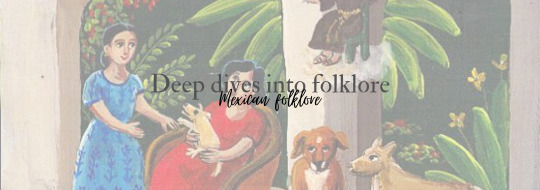
Within the vivid landscapes of Mexico, a captivating mosaic of folklore and mythology unfolds, echoing the voices of ancient civilizations and the whispers of colonial legacies. Mexican folklore, a vibrant narrative quilt, stitches together the threads of indigenous wisdom, Aztec myths, and the syncretic tales born during the Spanish conquest. In this exploration, we embark on a profound journey into the heart of Mexican folklore and mythology, unraveling the tales of gods and goddesses, mythical creatures, and timeless narratives that have woven a rich cultural tapestry throughout the annals of Mexican history.
Mexican folklore finds its roots in the pre-Columbian civilizations that flourished in the region, such as the Aztecs, Maya, and Zapotecs. The syncretism that occurred during the Spanish colonization further enriched the folklore by blending indigenous beliefs with Catholic traditions. This unique fusion gave rise to a diverse pantheon of deities, mythical creatures, and folk heroes, forming the foundation of Mexican folklore.
Aztec Pantheon:
Central to Mexican mythology is the Aztec pantheon, featuring deities like Quetzalcoatl, the feathered serpent, and Tlaloc, the god of rain. Myths surrounding the creation of the world, the struggles between gods, and the cyclical nature of life and death provide a rich backdrop to Mexican folklore.
La Llorona:
One of the most iconic figures in Mexican folklore is La Llorona, the weeping woman. Her haunting tale of love, betrayal, and maternal grief has been passed down through generations, resonating as a cautionary tale and capturing the imagination of storytellers and artists alike.
Nahualli and Nagual:
The concept of the nahual, an animal spirit guide, and its counterpart, the nagual, a human capable of transforming into an animal, reflects the deep connection between humans and the natural world. This belief persists in Mexican folklore, emphasizing the symbiotic relationship between the physical and spiritual realms.
Mexican folklore is not confined to the realm of ancient myths; it remains a living, breathing part of the culture. Festivals, celebrations, and religious rituals often incorporate elements of folklore, providing a link between the past and the present. Day of the Dead (Día de los Muertos) is a prime example, where families honor their ancestors and celebrate the continuity of life through a blend of indigenous and Catholic traditions.
Mexican folklore has profoundly influenced the arts, literature, and visual culture of the nation. Muralists like Diego Rivera and writers like Octavio Paz drew inspiration from the mythic past, infusing their works with the symbolic imagery and narratives of Mexican folklore. Contemporary artists, such as Frida Kahlo, continue to explore and reinterpret these mythic themes, contributing to the ongoing evolution of Mexican cultural identity.
In conclusion, Mexican folklore and mythology are indispensable facets of the nation's cultural identity, reflecting the resilience and creativity of a people shaped by diverse historical influences. From the ancient civilizations to the present day, these myths and tales continue to weave a narrative tapestry that resonates with the soul of Mexico. As the stories of gods, heroes, and spirits endure, they provide a timeless connection to the past and offer a source of inspiration for future generations, ensuring that the echoes of the ancestors will continue to reverberate through the cultural landscape of Mexico.
Taglist (reply or reblog to be added): @axl-ul @crow-flower @thoughts-fromthevoid @alderwoodbooks @harleyacoincidence @tuberosumtater @sonic-spade @theonlygardenia @holymzogynybatman @nulliel-tres @w0rkah0licz @sylvanthorn @tigertaurus22 @profiterole-reads @mathias-musings @1899adgg1997tbmd @grimmparanormalinvestigations
#writeblr#writers of tumblr#writing#bookish#booklr#fantasy books#creative writing#book blog#ya books#ya fantasy books#writers block#teen writer#writblr#tumblr writers#writerblr#writer problems#writers#writers community#writers corner#writers on tumblr#writerscommunity#writerslife#writing blog#writing community#mexican folklore#deep dives into folklore#folklore#myths#mythology
7 notes
·
View notes
Text
Corrins in FEH: Distinctions between the Male and the Female
Preface
Firstly, congratulations to Female Corrin in winning this year’s CYL. Though I’m more of a Male Corrin fan so I would be lying that I am not a bit sad with the results. But hey at least he’s top 15 (for Men). Anyways…
Something interesting of all the “avatars” is that Corrin, in each gender, represents the two main paths, Female from Conquest and Male from Birthright. As it is illustrated in their respective box art. I won’t argue if this makes it canon or not, however their portrayal beyond their games have also followed suit. For example, from what I heard about Warriors, correct me if I am wrong, is that Male by default gets Hoshidan noble and whereas Female has Nohrian noble. But I’ll focus on FEH as it’s the game I’m more familiar with and accessible for me.
Let’s talk about their portrayal in FEH. In their base alt(i.e., OG) it is ambiguous which route each took but in their seasonal alts, it’s pretty obvious that male does come from BR and whereas Female from CQ. I attempted to take notes of some of the differences between the two , from castle quotes, voice-lines ,Lv 40 confession and meet the heroes page. I noticed that they do have contrasting differences. Here’s a table of summary:
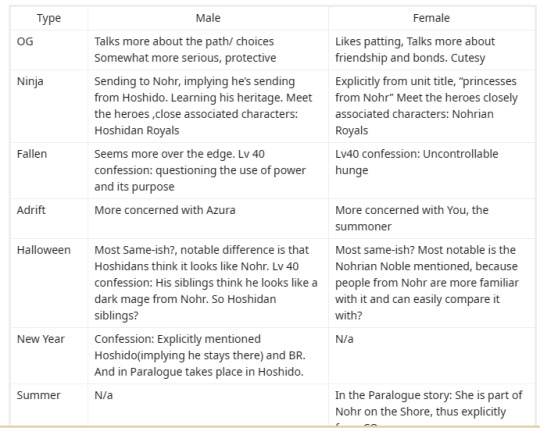

Brief Discussions
OG
Both of them have mostly the same lines and even the same Meet the heroes entry but interestingly, they have some differences in their castle, voice lines and even confessions. Male emphasizes about choices and road taken has a somewhat serious tone while Female more on bonds and cheery. Though it is vague which route each took so it is on you how to interpret it.
(However one may say as what male Corrin’s Yato sprite looks like the Omega variant meaning he’s from Revelations. But I argue that it’s contradicting with his art and weapon name that has the standard Yato. I think IS that time just gave him the Omega Yato sprite that early as they didn’t think FEH would last long.)
Ninja
Of all the Corrin alts that have both male and female versions, so far the Ninja alts are the most different and their lines are very different and it isn't vague which route each represents. If you read all their lines and the Meet the heroes page, definitely Ninja Male Corrin is definitely from Birthright and the Female one is from Conquest, the closely associated characters is a big hint. And it’s neat that they had encountered each other.
Another note, this line also intrigued me from their paralogue:
“It's definitely a bit shocking, at least
you still get along with your siblings!
Oh, Elise... As upbeat as ever, I see.”
-Ninja Male Corrin Paralogue 65-1
I find this intriguing because it references about his experience from Birthright and he had a reaction when he saw Elise. However in his voice lines and castle lines he mentions sending Ninja clothes to Elise, there are two theories I could think of—One, she survived in that reality, or Two, it is some sort of in honor of her loving memory.
Fallen and Adrift
These alts don’t have much indication of which road was taken since fallen are presumed from the pre route split and adrift ones are just Young Azura’s imagination.
The Fallen lines seem similar for both of them—about them suffering , anxious and trying to contain their powers and rephrasing one another. From what I could tell, Fallen Male Corrin seems more unstable than Female. While in their Adrift forms, Male Corrin is very concerned more with Azura while Female is more concerned with the summoner.
Another note is no indication about Revelations of all the alts except these alts. In the Meet the Heroes Page of Fallen(both), there’s a mention of Valla while the rest of Corrin entries none. And for Adrift, the paralogue takes place in Valla.
Halloween
Of all the Corrin seasonal alts, this is the most similar for the both of them, they almost say exactly the same lines or rephrasing in both castle and voice, even confession. Though I found some nuances that implies Male Corrin is from Hoshido while Female is from Nohr. Just like in Ninja Paralogue, they meet too and they’re BFF’s, literally “friends with myself”.
Unique Alts
Meaning that these alts have no counterpart in respective gender (yet) like New Years is exclusively for Male while Summer for Female. Despite that, it’s pretty obvious which one is from, Male again from Hoshido—voice-lines and the paralogue takes place in Hoshido, together with his Hoshidan brother Takumi, (though Camilla is there for some reason). And Female, no need for explanation as it is explicit in the title in her paralogue “Nohrian summer” and as Anna stated that this takes place in the world of Conquest.
As for Legendary Female Corrin, it’s very explicit that she’s from Conquest. In all her lines talks about the events in the CQ route. By following this precedent, it’s pretty obvious that in the near future Legendary Male Corrin will be from Birthright. And I can’t wait to hear his thoughts about the BR route too. And that would be a huge help too in my analysis I’m writing—“Lord Corrin, Second Prince of Hoshido”. It’s still WIP.
Resplendent
Recently Female got her too so I guess I’ll include this but I couldn’t find something notable. They just both doing role-play with the realm that their resplendent represent— Male talks about future as he represent Askr while Female like a dark fairy as she represents the fairy land (sorry can’t remember the hard to pronounce Norse name). So far there has been a pattern Askr for Hoshidans (Takumi is a fitting exemption and his resplendent makes sense) while Fairyland for Nohrians.
Side note, I just love Male Corrin’s special line “This is the end!”, I like this aggressive side of him.
Quick comparisons with other “Avatars”
Before I’ll conclude, I did some quick checks with other avatars: Kris, Robin,and Byleth, if they also exhibit some differences between Male and Female too. ( I only checked the ones having counterparts, unique seasonals I didn’t because I won’t have something to compare with. I didn’t include Shez and Alear since they’re new and I’m not very familiar with them yet.)
Kris’: They both say the same but Male emphasizes on training, while Female about serving and loyalty to Marth.
Robins: Same with Kris. They say the same or rephrasing some lines however in their confessions and some lines Male is about bonds and partnership while Female reminds of herself about the summoner. As for the Grimas, meh. Personally not a fan, can’t finish reading their condescending lines. “Worm this, worm that.”
Byleths: Kid you not, all lines are exactly the same, not even rephrasing, even exactly same confessions, literally copy-pasting.I may know the reason. As far as I know, they’re supposed to be emotionless for lore reasons which gives them a little variety.
Conclusion
Of all the “avatars” Corrins provide variety with their alts and there are distinctions between Male and Female, not just simply copy-pasting most lines for each gender unlike other avatars most especially Byleth.
By nature, they are the same—kind, trusting, endearing and optimistic, but by nurture (i.e., taking different paths and experiences) makes them a bit different. From what I could tell in their overall portrayal in FEH, Male Corrin seems to be somewhat serious, low-key melancholic, emphasizes choices and path to peace while his Female counterpart who is easy going, cutesy and emphasizes bonds. With these distinctions between the two, the notion that “they’re just the same person but different gender” could be challenged, for FEH at least.
( Wanted to recheck and compare their lines in their own games too but so many lines to read and I won’t have much spare time soon. So far I’ve noticed they have different support lines for Gen 2. For example, with Male Corrin support with Kiragi, they’re doing hide and seek, while Female, they had a conversation about Kiragi’s role as a royal)
In their seasonal alts, they act goofy and a kid at heart. This can be said to all seasonal alts too. But this really makes sense to them due to their locked in a tower childhood. They would naturally act this way as they enjoy to the fullest of their freedom and be mesmerized with new things.
As we have seen, it has been consistent which route represents who. Male for Birthright and Female for Conquest. Even their kid: Kana hints which road was taken from by their refined weapons. I’m certain that Male Corrin will get Hoshido Noble from his legendary to mirror the female counterpart. I haven’t found one that heavily implies from Revelations yet. It is very likely that Brave Female Corrin will break this pattern or IS will throw a curveball at us as usual.
I am glad that the characterization of Corrin in FEH is surprisingly good and gave them some depth and nuances despite how much the fandom loves to make them into overly peaceful, naïve and silly caricatures, and especially Female Corrin who is reduced to fan-service. I hope this will make people warm up more to Corrin.
And with that concludes my attempt of doing “”analysis””. I’ve put more effort into writing this than I ever did with my school essays. Like this has ~1800 words and I didn’t resort to using redundant word extending techniques. This shows how interest and passion would make you do. I did my best with all my abilities and limits and I hope I didn’t miss something. If something was overlooked, please politely correct me and please don’t kill me…
#male corrin#fire emblem corrin#m!corrin#corrin#fire emblem fates#fire emblem heroes#female corrin#analysis#fe heroes
31 notes
·
View notes
Text

A while back I drew various historical Starks in neolithic-to-bronze-age clothing, and I decided to expand on that for various historical figures - from right to left, in clothes ranging from bronze age to late antiquity, we have Nymeria, Florys the Fox, Lann the Clever, Elenei, Theon Stark the Hungry Wolf, Daenys the Dreamer, and the Amethyst Empress.
Art notes beneath the cut:
Nymeria is inspired by ancient Sumerian clothing; her spear in particular is based on an artifact from Girsu, but with a stylized sunburst in place of its engraved lion.
Florys is inspired by pre-Roman Gaul; I wanted something similar but distinct from the Stark look, as the legend is part Andal and part First Men, plus the plaid dress was fun to draw.
Lann is Greek; his hat is a petasos, which is associated with Hermes and I thought would emphasize the trickster aspect of his legend.
Elenei is Minoan, which was tremendous fun to draw, though I did cover up her chest more than a Minoan woman would have. She's also shaded more sea-green, to emphasize the not-quite-human aspects.
Theon Stark is more or less a retread of my Bronze Age Brandon "Him They Called Ice Eyes," based on various burial artifacts in Denmark but with Vlad the Impaler's mustache and the crown of the North added to his hat.
I'm hardly the fist to make the Targs Byzantine, but there's a reason for that: it just works. It's also a significantly later period than everyone else, as she moves from "the mists of time" to "just pre-Conquest."
The Amethyst Empress is Shang Dynasty, though the jewelry is mostly fantasy. I really wanted to draw full trailing sleeves, hence the pose, but it turns out they weren't really a thing yet - though there were some excellent hats.
Brush credits to FireAlpaca.
#a song of ice and fire#asoiaf fanart#nymeria#florys the fox#lann the clever#elenei#theon stark#daenys the dreamer#the amethyst empress#house martell#house stark#house targaryen#my art
15 notes
·
View notes